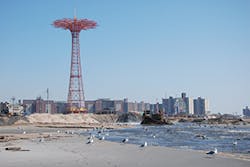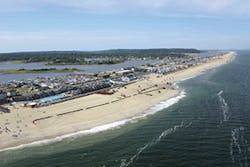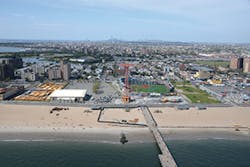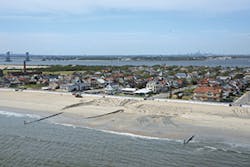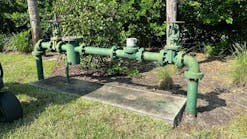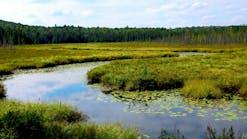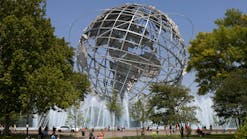Days after Hurricane Sandy hit the Atlantic Coast of the United States in 2012, coastal engineers with the US Army Corps of Engineers, New York District, were walking the beaches to see the damages. One of them was on a New Jersey beach and was stunned to see a house completely demolished, close by a house that looked like it was barely touched by Sandy’s force.
Why was this? The house that was still standing was on a beach that had previously received beach nourishment and dunes from the Army Corps.
Other projects the Army Corps visited sent the same message: Beach nourishment and dunes are extremely important to reducing coastal damages after storms and hurricanes. In fact, post-Sandy analysis shows that Army Corps’ beach nourishment projects in the states of New York and New Jersey saved an estimated $1.3 billion in avoided damages.
Now the Army Corps is taking these findings to improve future beach nourishment projects.
New York District’s Coastal Mission
The Army Corps’ New York District is responsible for the coasts along New York City and Long Island, NY, and the New Jersey coast as far south as Manasquan. In addition, it’s responsible for the portions of the Passaic River, Rahway River, South River, and the Raritan and Sandy Hook Bayshores that are affected by the coastal tides.
Anthony Ciorra, senior program manager with New York District, says, “The forces of Hurricane Sandy eroded approximately 6 million cubic yards of sand from the coasts of New York and New Jersey, where the District has responsibility.”
The Army Corps has replenished these coasts with approximately 15 million cubic yards of sand,
which is enough to fill the MetLife Stadium—a football arena located in New Jersey—three times over. Ciorra says some of the areas that were replenished in New York include Coney Island Beach, Rockaway Beach, Gilgo Beach, West of Shinnecock, and Westhampton Beach. In New Jersey, Sea Bright to Manasquan and Keansburg were replenished.
A sand-replenished beach with dunes can prevent elevated ocean waters, caused by storms, from inundating coastal communities.
Beaches lose their sand over time due to wave action and longshore currents. During hurricanes and coastal storms such as Hurricane Sandy, the fierce breaking waves and elevated water levels can change the width and elevation of beaches and accelerate erosion.
Communities are vulnerable to damages from hurricanes and coastal storms if their beaches are eroded. In addition, wildlife that relies on the beach as a habitat is also at risk. So it’s important to replace this sand.
Beach Nourishment Process
During a beach nourishment project, large volumes of beach-quality sand, called beachfill, are added from outside sources to restore an eroding beach.
“The Army Corps tries to match the sand to the native sand of the beach that is being nourished,” says Ciorra. “This is done for environmental habitat consistency; to be in balance with the forces of waves, tides, and currents; and for the community beachgoer experience.”
Usually, ocean dredges gather sand from offshore sand borrow areas and pump it through pipelines onto the beach. Sometimes it is more cost effective to transport the sand from quarries using trucks if the project needs only a small quantity of sand.
The sand can be placed in different areas of a beach depending on the project design. Sand can be placed to increase the height and width of a berm of the beach. The berm is a flat area of the beach between the landward shore and the ocean where beachgoers typically sunbathe.
The sand can also be placed offshore in an underwater berm, or stockpiled on a feeder beach from which the sand can naturally distribute to other parts of the project. The sand can also be used to create sand dunes. Sand dunes are areas of the beach where sand is elevated several feet and acts as a buffer between the waves and stormwater levels and the structures landward of the beach.
Determining whether dunes are needed has become a more pressing question in the last few years, especially after Hurricane Sandy.
Constructing a dune has to be necessary and cost effective, says Ciorra. “For example, one project area had a high backshore elevation. In this case, a dune is not necessary if the land behind the beach is over 18 feet above sea level. And in another project, the beach already had a seawall that was more than 21 feet above sea level, which acted as a de facto more permanent dune.”
If it’s determined that a dune is necessary, the dune’s sand volume itself isn’t very costly, but how a dune is situated on a beach berm can make it a more costly project. Creating dunes pushes the beach berm more oceanward because of the footprint of a dune.
If a berm is 75 or 100 feet wide and a dune is created that has a 50-foot-wide footprint, this will reduce the size of a berm. It will then be necessary to add sand to that berm to increase its full design width.
Additional structures may be constructed to help maintain the beach nourishment work. For example, groins are designed to retain sediment moving along the shore and help maintain the wide beaches by minimizing or slowing down erosion. Groins are shoreline structures that are perpendicular to the beach that are made of large boulders, concrete, steel, or wood.
After a beach has been nourished with sand and dunes, work on the beach doesn’t end. Sand on beaches naturally erodes, and because of this beaches need to be replenished with sand every few years, depending on the location.
Keeping the Environment in Mind
The Army Corps has many environmental restrictions that determine when it can perform this work. When beach nourishment and replenishment takes place depends on the environment of the area.
Beaches are prime wildlife habitats for birds including piping plovers and least terns and plants like the seabeach amaranth. If a beach doesn’t have these species, sand can be placed there anytime. Once beaches become habitats for these species, the typical season for dredging and pumping sand onto beaches is approximately from September through March when the birds are not present on the beach. This is also the safest time of the year for dredges to be out in the ocean because there is less threat of hurricanes and high waves.
When the dredging takes place, the dredge workers also take measures to protect the environment. Most dredges are equipped with whale, seal, and sturgeon monitors and with deflectors to prevent sea turtles from getting caught in the dredge equipment.
The Army Corps not only protects habitats, but also, as a result of sand nourishment, may help recreate them by restoring degraded beaches.
The Sea Bright to Manasquan project in New Jersey
Post-Sandy Beach Nourishment Findings
After Hurricane Sandy, the Army Corps examined its beach nourishment projects across the northeastern US, many areas of which faced the greatest intensity of the hurricane. The Army Corps performed an analysis to identify which beach nourishment projects were more effective in reducing storm risk to the shore communities; the analysis showed that beach nourishment and dunes were important in some areas.
“The beaches that had previously received beach nourishment and dune construction sustained less damages and saved an estimated $1.3 billion in avoided damages along the New York District’s shorelines,” says Ciorra.
Coney Island Beach
One of the beach nourishment projects that demonstrated a great reduction in damages was Coney Island Beach in the Borough of Brooklyn, New York City. The beach was designed to protect against storm surges and erosion. Hurricane Sandy’s surge pushed sand up and over the beach’s boardwalk, but the impacts behind the constructed project were minimal due to the beach’s high elevation. “As a result, there was an estimated $494 million in avoided damages to houses and structures,” says Ciorra.
Another project was the Fire Island to Montauk Point–Westhampton Interim beach nourishment project on Long Island.
Lynn Bocamazo, senior coastal engineer and chief of the New York District Engineering Division’s Hurricane Sandy Branch visited this beach after Hurricane Sandy and witnessed how the high dunes resulted in an estimated $107 million in avoided damages.
Sand replenishment work taking place on Rockaway Beach, New York
Bocamazo notes that the dunes have grown to different heights along the project area, and the shorter dunes in one location were the only ones topped by water during Hurricane Sandy. This showed that a dune and beachfill project significantly acted as a protective barrier, thus confirming the Army Corps designs.
According to Bocamazo, beaches that did not have beach nourishment and dunes prior to Hurricane Sandy experienced much more coastal damage. Some of these beaches sit right next to beaches that had been constructed, and the comparison was striking.
Bocamazo saw the same results in New Jersey. The Sandy Hook to Barnegat project stood up well after Hurricane Sandy and resulted in an estimated $323 million in avoided damages. Within the Sandy Hook to Barnegat project is a 3-mile area in Deal to Loch Arbour, NJ, that has never had beach nourishment. There she saw one building completely demolished standing near a house that had minimal damage.
It was a similar situation in New York City at Rockaway Beach in the borough of Queens; the area didn’t have dunes and was totally inundated with water. Based on these findings, the Army Corps’ New York District is reexamining areas that originally didn’t include dunes.
Atlantic hurricanes can occur every season, from June to November, but what is steadily occurring is sea level rise associated with climate change, and the Army Corps believes that beach nourishment and dunes are an answer to dealing with it.
“Addressing this is straightforward; the dunes can be made higher each time sand replenishment is done on a beach,” says Ciorra. “The Army Corps performed a study and found out that it is cost effective to create a dune foundation now on a beach in anticipation of having to raise the dune in the future because of climate change.”
On the whole, communities in the Northeast are well educated about beach nourishment, but there are still those who don’t understand the importance of the work and how ultimately it can help reduce damages to their property.
Bocamazo says some communities don’t want change. The Army Corps understands this and does only the work requested by a community. She says, “The Army Corps tries very hard to not make the beaches different, just larger with higher dunes. Waves and high water are going to come and hit the properties in your community. This will happen less often if you have a beach nourishment project.”
